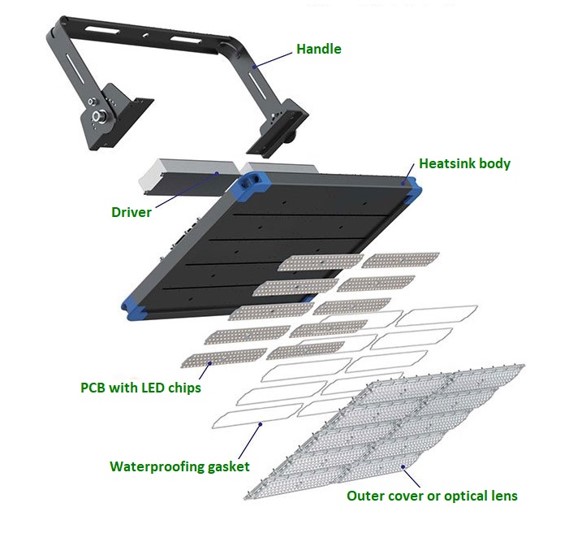All About Hydroponics
the root system - from the bottom up
In nature, plant roots receive water saturated with oxygen following a rainfall
As the soil begins to dry, air permeates through the root hairs which absorb oxygen
For soil based plants it is important to allow the roots to draw in air by not over-watering
With hydroponics roots are suspended in water and therefore rapidly absorb oxygen
If the oxygen content of the water is inadequate, the plant growth will slow
An air stone or similar device located in the main water supply tank is recommended to ensure water is adequately oxygenate
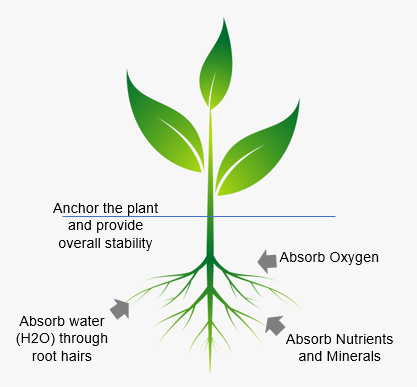
Ebb and flow hydroponic systems naturally provide a cycle of irrigation and aeration but nutrient supply needs to be balanced to ensure the plant receives sufficient nutrients during this cycle
“Constant drip” provides a more level balance of water, nutrients and oxygen
Nutrient Film Technique (N.F.T.) is based on the principle of a thin film of nutrient-rich water flowing slowly over plant roots which provides a constant supply of water, nutrients and oxygen to the root system
“Aeroponics” systems provide roots with a spray of nutrient rich water allowing air and therefore oxygen to reach the roots continually. This is a great method as long as there is no failure in the pumping system or clogging of spray nozzles
nutrients, ph and ec - striking the right balance
Primary nutrients are carbon, hydrogen, nitrogen, oxygen, phosphorus, and potassium
Plants obtain carbon, hydrogen and oxygen from CO2 (carbon dioxide), H2O (water) and air
Nitrogen, phosphorous and potassium are provided by nutrients as are secondary nutrients
Secondary nutrients include calcium, magnesium and sulphur and micro nutrients include chlorine, iron, zinc, manganese, boron, copper and molybdenum
You can purchase nutrients from a variety of on-line and retail hydroponic stores. Most stores offer a good balanced mix of nutrients to help you achieve good grow results.
Electrical conductivity (EC) is a measurement of the dissolved salts in a solution in an aqueous solution, which relates to the ability of the plant to absorb water and more importantly nutrients
EC should be kept in the range 1.2 to 2.0 for most plant types
An indicative EC range for plants is 0.8-1.3 for seedlings; 0.5-1.3 for cuttings; 1.3-1.7 for vegetative phase; 1.2-2 during flowering
Different varieties of plant might require different values of EC
pH stands for “power of Hydrogen” or “potential for Hydrogen”
pH is the measurement of the alkalinity or acidity levels in a water solution
It is measured on a scale from 1 to 14 where the upper half is alkaline and the lower half of the scale is acidic
A perfectly pure (neutral) solution is a 7 on the pH scale
In hydroponics, the ideal or standard pH level for plants is between 5.8 and 6.5. This pH level is ideal for the absorption of essential micro and macro nutrients by the plants’ roots
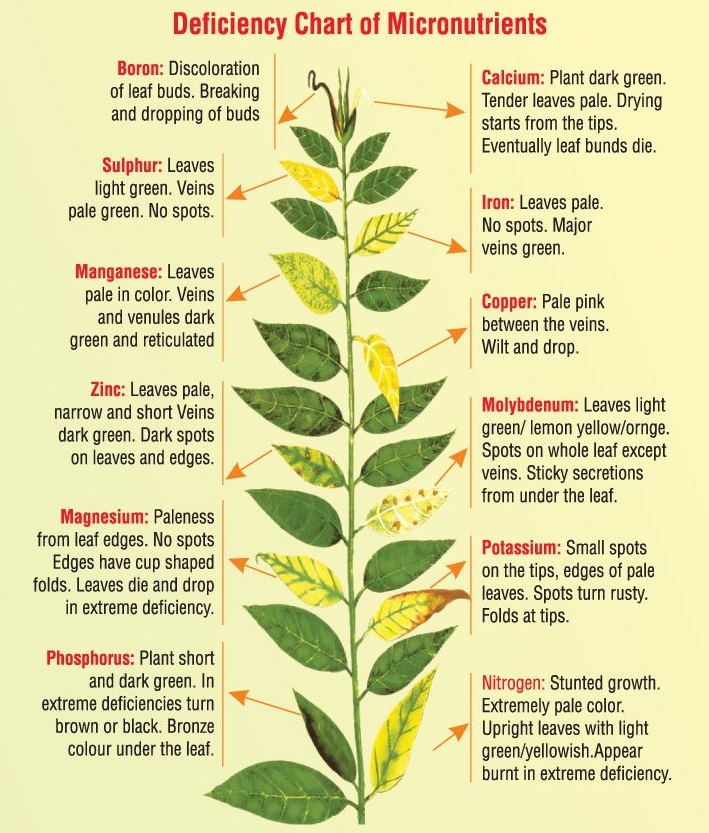
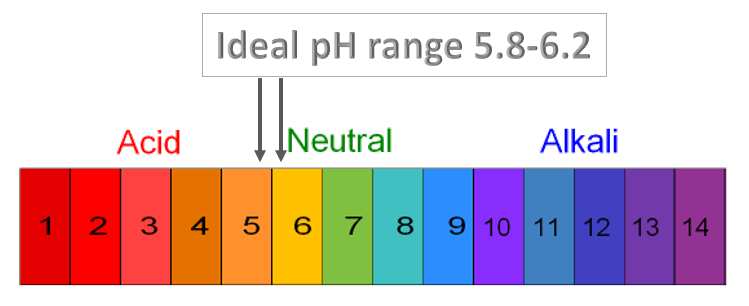
It is recommended that you test your water for pH and EC before adding nutrients or running your hydroponic water system through any grow media
Different grow media possess different natural levels of pH and once you have tested your unused water then run through the system before adding plants or nutrients to again see the effect of the grow media on the pH
Various meters are available from grow stores or Amazon
An automated EC and PH meter can be installed to increase or decrease nutrient levels automatically
temperature & humidity
Relative humidity (RH) is the ratio of the partial water in the air compared to full saturation of water in the air. RH of 100% is fully saturated. RH of 0% is fully dry
A humidity level that is too low in the grow room causes water loss from the leaves and when too high can cause mould, bacteria and diseases to form
RH is directly affected by temperature and temperature also affects the opening or closing of the stomata
When too hot, the stomata will close to limit evaporation which inhibits the photosynthetic process
When humidity is too high plants cannot evaporate water which also inhibits the uptake of water and nutrients through the roots and slows the photosynthetic process
Good ventilation and airflow is essential in the grow room
Airflow over the leaves ensures good transpiration (water evaporation) from the leaf
Ventilation removes heat from the grow room and replaces oxygen rich air with natural air which in turn replenishes CO2 in the grow room
Temperature and RH need to be set differently for different stages of growth
An indicative level for each is shown below:
Cuttings: temperature 23 to 25 °C (74 to 78 °F) and RH 75 to 80%
Vegetative stage : 21 to 25 °C (70 to 78 °F) and RH 45 to 55%
Flowering 20 to 24 °C (68 to 75 °F) daytime and 12 to 15 °C (53 to 60 °F) night-time with RH 35 to 45%
hydroponics systems explained
All of the 6 hydroponic systems described here require a reservoir that contains a mixed solution of water and nutrients. It is recommended that the reservoir is aerated using an air pump and air stone (available from all good hydroponic stores or Amazon )
NFT System : the water and nutrient solution and is pumped into a tray at one end. The tray has channels in it. The tray is mounted at a slight angle to allow the water to run down the channels. The plant roots extend into the channels and the nutrient / water solution constantly flows over the roots. The water is returned to the reservoir through a drain hole at the other end of the tray. Plants are typically grown in foam inserts inside plastic net pots. Ideal for larger plants. System maintenance is key to ensure channels do not become clogged and the pumps continues to circulate the water
Ebb & Flow System : otherwise known as flood and drain. Plants are grown in fabric pots filled with substrate such as coir, and the pots are placed on a tray that has channels in it. The tray is flooded with the mixed water / nutrient solution a few times a day depending on the size of the plants and their transpiration rates. The water then drains slowly back into the reservoir. This allows oxygen to be pulled into the roots. Ideal for larger plants but vigilance is needed to make sure the roots do not dry out too much between pumping cycles
Drip irrigation System : typically used on large-scale commercial installations, this systems uses a pump to push water through a pipe that circulates throughout the grow room. The pipe has drip emitters at each plant position and drips water into the substrate. Plants are typically held in fabric pots or a grow bag containing a substrate such as coir
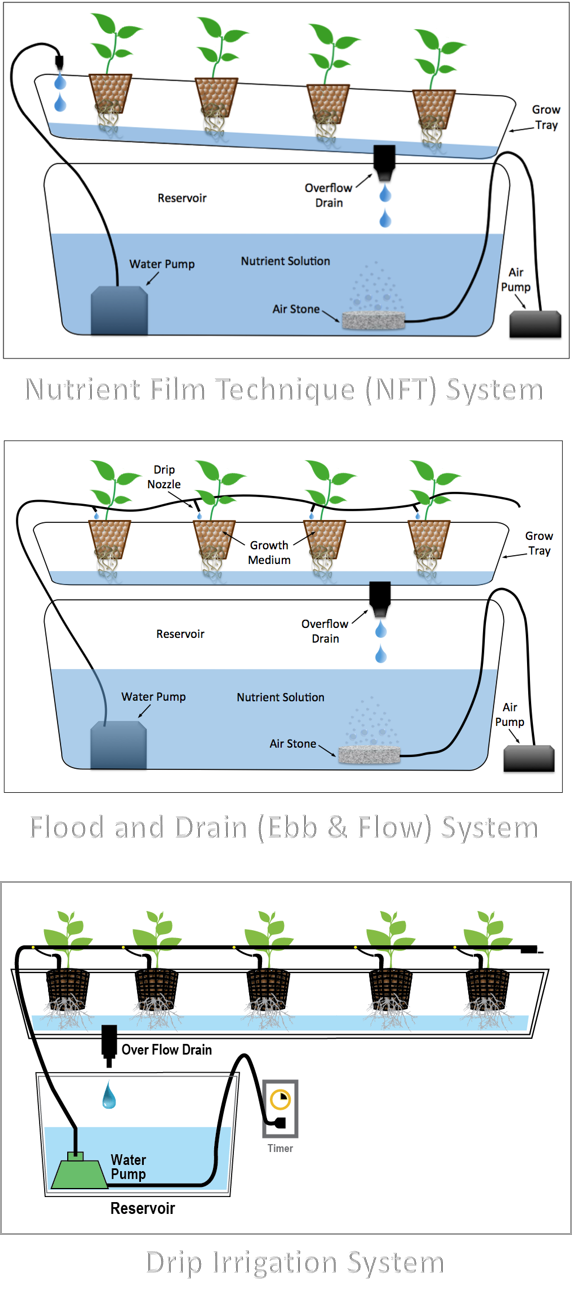
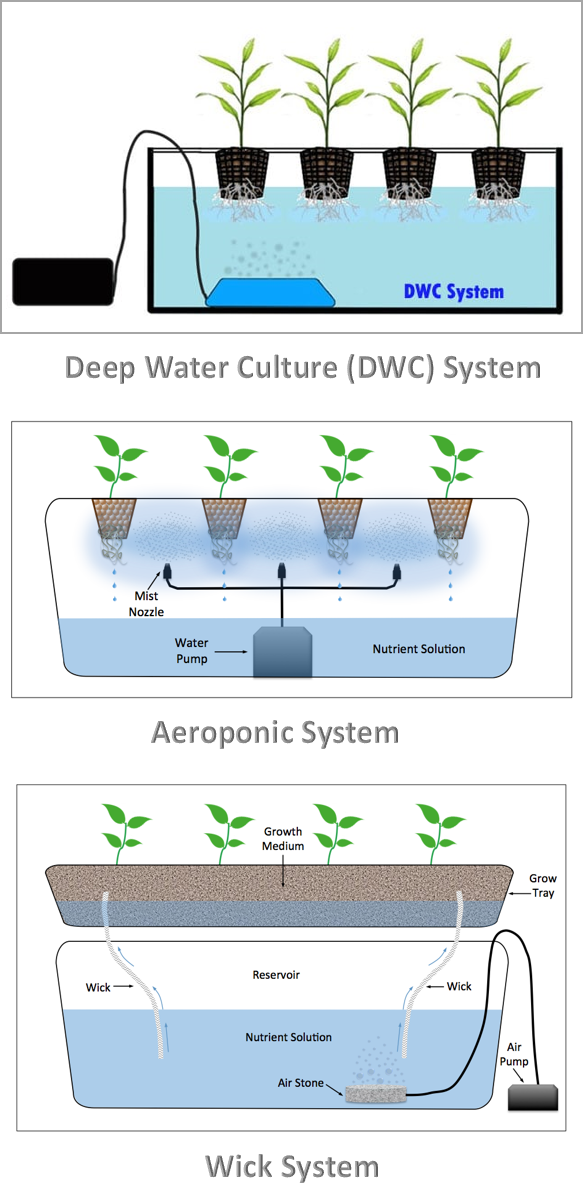
DWC system : in this system the plant roots are suspended in that reservoir solution so they get a constant supply of water, oxygen, and nutrients. Plants are typically housed in net pots that are placed in a foam board or into the top of the container that you’re using for the reservoir. Good for small and mid-sized plants
Aeroponic System : an aeroponic system is similar to a NFT system but in the case of aeroponics, the roots are constantly suspended in air and the water / nutrient solution is misted or sprayed onto the roots. This allows excellent absorption of oxygen into the root systems and some growers express improved plant growth because of this. The system needs high levels of maintenance to ensure the spray nozzles continue to function correctly. Ideal for small to mid-sized plants
Wick System : nutrients and water are moved into a plant’s root zone via a wick, which is often something as simple as a rope or piece of felt. This is a very simple system that requires no pumps. Wick systems are good for smaller plants that don’t use up a lot of water or nutrients
optimal grow conditions
Light = 120 to 300 umol/m2/s salad and herb crops and 650 to 1000 umol/m2/s for larger bushy flowering crops.
Temp 21 to 25 deg C (70 to 77 deg F)
Humidity 45 to 65%
Wind / air flow – leaf movement as a minimum
CO2 = ambient is 400 ppm challenge with CO2 to keep at least at this. Ideally up to 1,000 to 1,200 ppm
Remember, plants add about 30% bulk and height when flowering
Coconut coir good substrate
Nitrogen balance 20-10-20 (Nitrogen, Phosphorus, Potassium)
Slightly over water
Plenty of aeration in the water
An indicative EC range is 0.8-1.3 for seedlings; 0.5-1.3 for cuttings; 1.3-1.7 under vegetative phase; 1.2-2 during flowering
Different varieties of plant might require different values of EC
Ideal PH between 5.8 and 6.5
F.A.Q.
if you cannot find the answer to your question then please send via contact page
Water (H2O) naturally contains oxygen and plants will grow adequately with no additional oxygenation. However, by drawing extra oxygen through their root system, plants can achieve greater growth and higher yields. As such, adding an airstone to your water reservoir to oxygenate the water is recommended.
This often comes down to personal preference and ease of use. A popular system is the Ebb & Flow or NFT system because of their low cost, ease of installation, and success in growing plants very well.
This depends on what you are growing, the PH level of your supply water and the condition of your plants. the guides in this website above show what sort of plant conditions result from nutrient imbalance. The two nutrients shown above, with links to buy from Amazon, are very good base nutrients for all types of growth.
It is advisable to install an air extraction fan in your grow room and air inlet aperture. The outlet fan ensures CO2 rich air is emitted from the grow room with fresh air drawn in through the inlet aperture. When air exchange takes place, moisture in the air is emitted to the outside and hence you can use the extraction system to lower humidity levels. A hydroponic system containing water and operating in an air temperature of between 20 and 25 degrees C will naturally increase humidity levels. Purchase a temperature sensor and hygrometer (humidity sensor) and set your air extraction to operate periodically to help control humidity levels.
Plants emit oxygen and water through their stoma during the photosynthetic process. An airflow fan improves this transpiration process and therefore an airflow fan is recommended.

